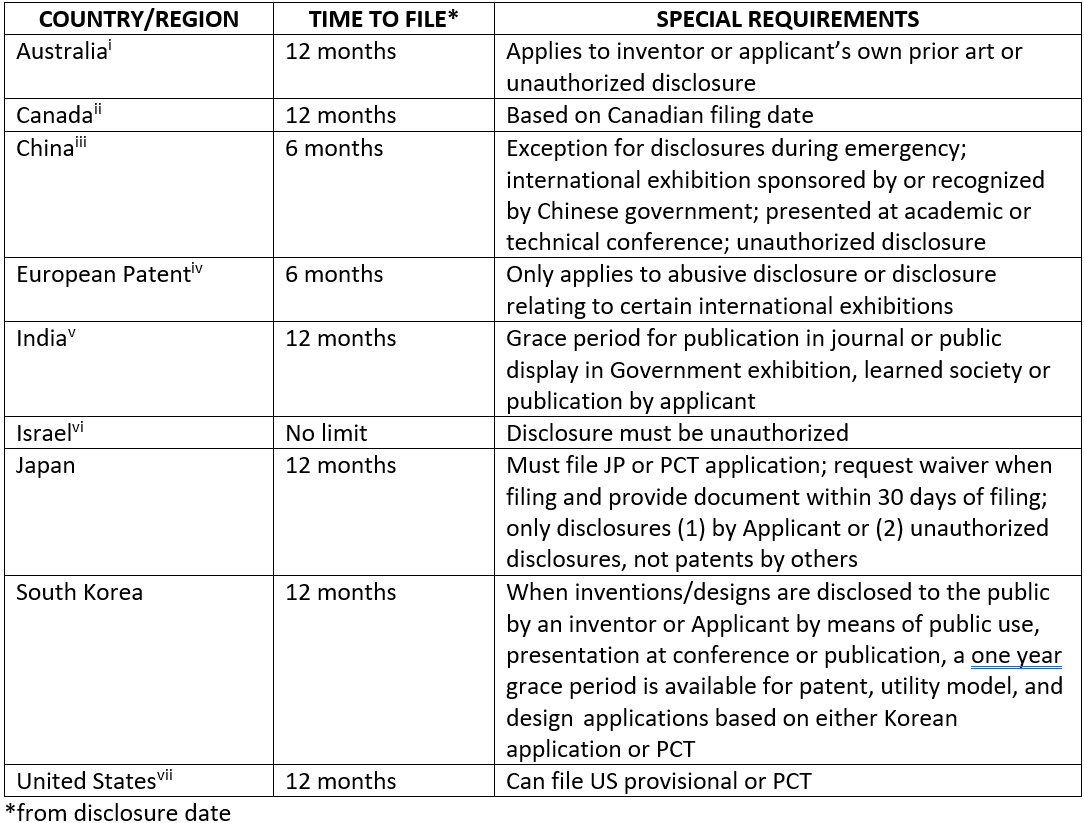There are TWO common misconceptions:
1. That only the US has a grace period. Absolutely wrong.
2. That you cannot utilize grace periods outside of the US. YES and NO:
You cannot utilize a grace period outside of the US for an AUTHORIZED disclosure based on a US PROVISIONAL application.
IF you file a PCT application (and preferably ask the foreign agent to make any required filings – see, for example, Japan), you can get benefit of the grace period.
Over the last few years there have been many changes in patent law relating to so called “grace periods”
i.e., a period of time prior to filing for a patent in which a publication may be removed as prior art to a patent application. Grace periods allow an applicant to file a patent application after an invention has been disclosed, with certain caveats. In some jurisdictions, grace periods are limited to specific disclosures such as displays at officially recognized exhibitions, presentations at officially recognized academic or technical meetings, publications by officially recognized journals, or experimental testing. In some cases, grace periods are limited to disclosures made by the Applicant. In all cases, there is a non-extendible time period to file in the country in which the grace period is to be claimed. This means that filing of a provisional application in the U.S. patent office may be sufficient to claim the grace period in the U.S., but it is
not sufficient outside the U.S. Therefore, in order to take advantage of as many grace periods as possible, Applicant must either file directly in the countries of interest
or file a PCT application.
Grace periods can also protect a patent application from indirect public disclosure. That is, public disclosure made by a third-party, through the applicant. For example, in Canada, public disclosure made by a third-party who obtained knowledge from the applicant is not considered to be prior art. Unauthorized disclosure, in which public disclosure is made in breach of the applicant’s confidence, may also benefit from grace periods. Other jurisdictions have similar provisions, but they must be asserted and there must be sufficient and compelling evidence to support the assertion that the information was owned by the Applicant, was maintained as confidential by the Applicant, and the disclosing party knowingly breaching this confidentiality.
The following is a brief summary of the requirements for select countries or regions. A complete up to date list can be found at: https://www.wipo.int/export/sites/www/scp/en/national_laws/grace_period.pdf

i PATENTS ACT 1990 - SECT 24
Validity not affected by making information available in certain circumstances
(1) For the purpose of deciding whether an invention is novel or involves an inventive step or an innovative step, the person making the decision must disregard:
(a) any information made publicly available in the prescribed circumstances, by or with the consent of the nominated person or patentee, or the predecessor in title of the nominated person or patentee; and
(b) any information made publicly available without the consent of the nominated person or patentee, through any publication or use of the invention by another person who derived the information from the nominated person or patentee or from the predecessor in title of the nominated person or patentee; but only if a complete application for the invention is made within the prescribed period.
(2) For the purpose of deciding whether an invention is novel or involves an inventive step or an innovative step, the person making the decision must disregard:
(a) any information given by, or with the consent of, the nominated person or the patentee, or his or her predecessor in title, to any of the following, but to no other person or organisation:
(i) the Commonwealth or a State or Territory, or an authority of the Commonwealth or a State or Territory;
(ii) a person authorised by the Commonwealth or a State or Territory to investigate the invention; and
(b) anything done for the purpose of an investigation mentioned in subparagraph (a)(ii).
ii 28.2 (1) The subject-matter defined by a claim in an application for a patent in Canada (the “pending application”) must not have been disclosed
(a) before the one-year period immediately preceding the filing date or, if the claim date is before that period, before the claim date by the applicant, or by a person who obtained knowledge, directly or indirectly, from the applicant, in such a manner that the subject-matter became available to the public in Canada or elsewhere;
(b) before the claim date by a person not mentioned in paragraph (a) in such a manner that the subject-matter became available to the public in Canada or elsewhere;
(c) in an application for a patent that is filed in Canada by a person other than the applicant, and has a filing date that is before the claim date; or
(d) in an application (the “co-pending application”) for a patent that is filed in Canada by a person other than the applicant and has a filing date that is on or after the claim date if
(i) the co-pending application is filed by
(A) a person who has, or whose agent, legal representative or predecessor in title has, previously regularly filed in or for Canada an application for a patent disclosing the subject-matter defined by the claim, or
(B) a person who is entitled to protection under the terms of any treaty or convention relating to patents to which Canada is a party and who has, or whose agent, legal representative or predecessor in title has, previously regularly filed in or for any other country that by treaty, convention or law affords similar protection to citizens of Canada an application for a patent disclosing the subject-matter defined by the claim,
(ii) the filing date of the previously regularly filed application is before the claim date of the pending application,
(iii) the filing date of the co-pending application is within twelve months after the filing date of the previously regularly filed application, and
(iv) the applicant has, in respect of the co-pending application, made a request for priority on the basis of the previously regularly filed application.
iii Article 24 of the Chinese the Implementation Rules and Examination Guidelines. NOTE the term "academic or technological conference" refers to an academic or technological conference organized by relevant competent departments of the State Council or national academic organizations, excluding those conferences below the provincial level or entrusted by ministries and commissions of the State Council or national academic organizations, or the conferences organized in their names. The supporting materials for international exhibitions shall be issued by the organizer of the exhibition. The date, location, name of the exhibition, and the date, form, and content of the invention-creation being exhibited should be indicated in the supporting materials, and the official seal should be affixed. If it is published for the first time at a prescribed academic or technological conference, supporting (certificate) materials shall be issued by the relevant competent department of the State Council or the national academic organization that organizes the conference. The date, place, and name of the conference, and the date, form, and content of the invention-creation being published shall be indicated in the supporting materials, and the official seal shall be affixed.
iv Article 55 (Article 54 is novelty) Non-prejudicial disclosures
(1) For the application of Article 54, a disclosure of the invention shall not be taken into consideration if it occurred no earlier than six months preceding the filing of the European patent application and if it was due to, or in consequence of:
(a) an evident abuse in relation to the applicant or his legal predecessor, or
(b) the fact that the applicant or his legal predecessor has displayed the invention at an official, or officially recognised, international exhibition falling within the terms of the Convention on international exhibitions signed at Paris on 22 November 1928 and last revised on 30 November 1972.
(2) In the case of paragraph 1(b), paragraph 1 shall apply only if the applicant states, when filing the European patent application, that the invention has been so displayed and files a supporting certificate within the time limit and under the conditions laid down in the Implementing Regulations.
v https://ipindia.gov.in>Portal>images
vi Israeli patent law section 18.
vii AIA 35 U.S.C. 102(b)(1)(A) provides exceptions to the prior art provisions of AIA 35 U.S.C. 102(a)(1). These exceptions limit the use of an inventor's own work as prior art, when the inventor's own work has been publicly disclosed by the inventor, a joint inventor, or another who obtained the subject matter directly or indirectly from the inventor or joint inventor not more than one year before the effective filing date of the claimed invention. AIA 35 U.S.C. 102(b)(1)(A) provides that a disclosure which would otherwise qualify as prior art under AIA 35 U.S.C. 102(a)(1) is not prior art if the disclosure was made: (1) One year or less before the effective filing date of the claimed invention; and (2) by the inventor or a joint inventor, or by another who obtained the subject matter directly or indirectly from the inventor or joint inventor. MPEP § 2153.01(a) discusses issues pertaining to inventor-originated disclosures within the grace period. MPEP § 2152.01 discusses the “effective filing date” of a claimed invention.




